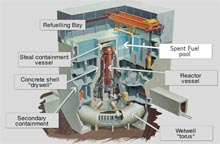Japan: Radiation Fears Mount Despite Partial Restoration Of Power At Nuclear Plant
By RFE RL
Workers at Japan’s stricken Fukushima Daiichi nuclear power plant have managed to reconnected power to the facility’s No. 1 and No. 2 reactors, a step they hope will soon allow them to restart the plant’s cooling system and avert a wider nuclear disaster.
The power is crucial to attempts by engineers to cool down all six reactors at the earthquake- and tsunami-damaged facility and limit further leaks of radiation.
The operator of the nuclear plant warned that it may take several days for power to be restored at the No. 3 and No. 4 reactors.
The partial restoration of power came with fears mounting of the deadly spread of radiation, which has already been detected in tap water in Tokyo, crops in the region that houses the Fukushima plant, and Japanese beans exported to Taiwan.
More than 8,000 people have been confirmed dead as a result of the March 11 earthquake and resulting tsunami, with 12,000 still missing. More than 250,000 people are staying in evacuation centers after the tsunami wiped away entire communities along the northern Japanese shore.
How Bad Is It?
Hundreds of demonstrators gathered in the Japanese capital on March 20 to criticize their government for failing to prevent a crisis at the Fukushima plant after the quake hit.
One of the protest organizers, Takashi Misumi, said authorities have failed to acknowledge the true scope of the disaster and called for Japan to abandon its nuclear energy program immediately.
“The government has no intention of stopping its nuclear operations. It says this will never happen again,” Misumi told Reuters. “I want to appeal to the world and say that this is very dangerous.”

Japan’s race to avert a full-scale meltdown at the Fukushima plant has sparked fresh concerns worldwide about the safety of nuclear power.
Those fears are now likely to rise even higher, as radiation contamination has been detected in vegetables, dust, and water near the nuclear zone.
Japan’s chief cabinet secretary, Yukio Edano, told a press conference that traces of radiation had been detected in two prefectures near the Fukushima plant.
Edano said the government is considering whether to ban the sale of food items, like spinach and milk, produced in the region.
“We will continue investigating the situation and analyzing what research needs to be done. We will decide by tomorrow [March 21] whether we need to impose restrictions on consumption in a specific region or whether we need to restrict the output of food products.”
The news has come to a blow to the region’s farmers, who stand to lose their entire harvest.
Much In Doubt
The Japanese government has been careful not to portray the power restoration at the Fukushima plan as a certain success.
It took 300 engineers braving high radiation levels to connect power to the plant’s No. 1 and No. 2 reactors, which will aid attempts to cool down the reactor and limit the leak of radiation. The facility contains six reactors, three of which were up and running when the country’s largest recorded earthquake struck.
Edano said the efforts were “showing some effect” but added that the government “was not in a position to be able to say anything” more about whether a nuclear crisis has been averted.
Both Japanese and foreign visitors have sought to leave Japan in the wake of the deadly earthquake and tsunami, which has caused widespread power outages and required massive rescue and reconstruction operations.
An 80-year-old woman and a teenage boy were rescued from the wreckage of a house in northeastern Japan a full nine days after the 9.0-magnitude earthquake that set off the catastrophe.
An official from the Taiwanese radiation watchdog said the amount of radiation detected on a batch of Japanese fava beans sent on March 18 was well below Taiwan’s legal limit and was not harmful to human health. He did not know where in Japan the beans originated.
